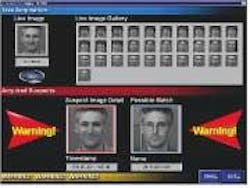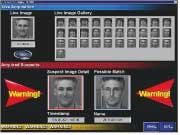Facial recognition takes off in airport security
by John McHale
LITTLETON, Mass. — Officials at Viisage Technology claim their facial recognition technology had a success rate in excess of 90 percent during passenger screening tests at airports around the country. "I feel safe letting my wife on a plane with that type of efficiency," says Cameron Queeno, chief marketing officer for Viisage.
Some of tests are still going on, such as the one at Logan airport in Boston. Some are being installed at locations such as Manchester Airport in Manchester, N.H., Queeno says.
The global war on terrorism calls for the ability to identify and track suspected terrorists and criminals at airports and sports events, as well as at military bases and nuclear power plants. The most promising technology for this is biometrics, which measures and statistically analyzes biological data such as face and eye patterns
"We have learned a lot about facial recognition technology since 9/11," Queeno says. "Most importantly in the way we deploy it," he adds. For example at tests before 9/11 at the Super Bowl and other facilities cameras would be set up for to watch people as they are walking and record an image of their face to be crosschecked with a database, Queeno explains. However, because the people were not directed to look into the camera, the images recorded were sometimes insufficient for recognition, he says.
Now facial recognition systems are becoming part of the regular airport security check-in, Queeno says. When a passenger goes through security he first puts his bags through the baggage-screening system, and then steps through the metal detector. Now security personnel will ask the passengers to look into a camera that will take pictures for the facial recognition system. The systems will take six impressions of the passenger's face then compare those to a database that would typically carry about a 1,000 people labeled as suspicious or worse, Queeno says.
Each passenger's face is usually erased unless he is resistant or security personnel label his behavior as suspicious, Queeno says. If a passenger refuses to look into the camera, he is not allowed on the plane, he adds.
If the operator of the facial recognition system finds a match, he can alert security personnel to perform a more extensive search of the passenger, ask security experts to keep an eye on the passenger in case he may make contact with someone else, and perhaps detain the passenger before he gets on the aircraft, Queeno explains.
"Facial recognition is a tool like baggage screening," Queeno says. Having passengers stop to look at a camera is easier than trying to pick them out of a crowd, he adds. Plus if someone is wearing a hat or trying to look away from the camera, he cannot get away with that when security is standing next to him, Queeno says.
The Viisage technology is also under consideration for law enforcement, Queeno says. For example, a police officer might pull someone over, use a handheld facial recognition device to take his picture. Then the police officer would plug into his laptop in his cruiser to crosscheck the suspects face against a national database, he explains. There is also talk about creating a smart card for frequent flyers containing their faces and fingerprints that would allow them to bypass long security lines, Queeno says.
Viisage has also licensed its technology to two companies, Curtiss-Wright in Lyndhurst, N.J., and Inforonics in Littleton, Mass., who are teaming on an electronic system able to combine several forms of biometric analysis for government, military, and commercial security
The Viisage family of face recognition products includes FaceEXPLORER, an image retrieval and analysis database product, used to combat identity fraud; FaceFINDER, a surveillance and identification system; FaceNET, which provides secure authentication for PC, Internet, and e-commerce connections; FacePIN, which provides private verification for point-of-sale transactions such as ATMs; FacePASS, a security solution for keyless entry to secure facilities, such as offices, dormitories, and government facilities; and FaceTOOLS, which that enables application providers to develop and customize customer and market applications.
Viisage's FacePASS has been successfully installed and is now operating at the U.S. Navy's Point Loma Submarine Base in San Diego. Viisage is working with the Navy to integrate its FacePASS solution into a mantrap environment that limits access to one person at a time and will enable the Navy to move from a manned facility to an unmanned facility, permitting access to the pier during off hours.
"Our initial findings have been promising," says Cindy Milholland, a project engineer for the Navy. "In the present environment, the system is performing the job of access control very well."
For more information on Viisage contact the company on the World Wide Web at http://www.viisage.com.

